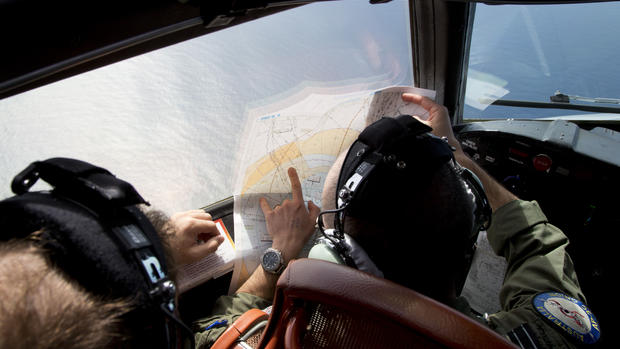Malaysia Airlines Flight 370: No new "black box"-like sounds heard
PERTH, Australia -- Search crews hunting for the missing Malaysia Airlines jet have failed to relocate faint sounds heard deep below the southern Indian Ocean that officials said were consistent with a plane's black boxes, the head of the search operation said Tuesday.
Angus Houston, the retired Australian air chief marshal who is heading the search far off Australia's west coast, said sound locating equipment on board the Ocean Shield has picked up no trace of the signals since they were first heard late Saturday and early Sunday.
Time may have already run out to find the devices, whose locator beacons have a battery life of about a month. Tuesday marks one month since the plane vanished. Once the beacons blink off, locating the black boxes in such deep water would be an immensely difficult, if not impossible, task.
Up to 14 planes and 14 ships are scouring the 30,000-square-mile search zone.
The wait has been devastating for weary families, CBS News correspondent Seth Doane reports. Many insist the search continues at all costs, despite the frustrations.
It is unclear whether a sub on board the Ocean Shield will be deployed to try to chart out any debris on the sea floor when searchers are certain the black boxes' locator beacons have gone silent. If the sub maps out a debris field, the crew will replace the sonar system with a camera unit to photograph any wreckage.
Houston's comments about deploying the sub contradicted an earlier statement from Australia's acting prime minister, Warren Truss, who said search crews would launch the Bluefin 21 autonomous sub on Tuesday.
The towed pinger locator detected late Saturday and early Sunday two distinct, long-lasting sounds underwater that are consistent with the pings from an aircraft's "black boxes" - the flight data and cockpit voice recorders, Houston said, dubbing the find a promising lead in the month-long hunt for clues to the plane's fate.
Still, officials warned it could take days to determine whether the sounds were connected to Flight 370, which vanished March 8 on a flight from Kuala Lumpur, Malaysia, to Beijing with 239 on board.
Houtson said finding the sound again was critical to narrowing down the search area before the sub can be used. If the vehicle went down now with the sparse data collected so far, it would take "many, many days" for it to cover all the places the pings might have come from.
"It's literally crawling at the bottom of the ocean, so it's going to take a long, long time," Houston said.
Despite the excitement surrounding the Ocean Shield's sound detections, Houston warned that the search had previously been marred by false leads - such as ships detecting their own signals. Because of that, other ships cannot be sent in to help with the underwater search, as they may add unwanted noise.
"We're very hopeful we will find further evidence that will confirm the aircraft is in that location," Houston said. "There's still a little bit of doubt there, but I'm a lot more optimistic than I was one week ago."
Finding the black boxes is key to unraveling what happened to the Boeing 777, because they contain flight data and cockpit voice recordings that could explain why the plane veered so far off-course.
The first sound picked up by the equipment on board the Ocean Shield lasted two hours and 20 minutes before it was lost, Houston said. The ship then turned around and picked up a signal again - this time recording two distinct "pinger returns" that lasted 13 minutes. That would be consistent with transmissions from both the flight data recorder and the cockpit voice recorder.
The black boxes normally emit a frequency of 37.5 kilohertz, and the signals picked up by the Ocean Shield were both 33.3 kilohertz, U.S. Navy Capt. Mark Matthews said. But the manufacturer indicated the frequency of black boxes can drift in older equipment.
Houston said the frequency of the sounds heard was considered "quite credible" by the manufacturer, and noted that the frequency from the Air France jet that crashed several years ago was 34 kilohertz. Pressure from being so deep below the surface and the age of the batteries can also affect the transmission level, he said.
The frequency used by aircraft flight recorders was chosen because no other devices use it, and because nothing in the natural world mimics it, said William Waldock, a search-and-rescue expert who teaches accident investigation at Embry-Riddle Aeronautical University in Prescott, Ariz.
But these signals are being detected by computer sweeps, and "not so much a guy with headphones on listening to pings," said U.S. Navy spokesman Chris Johnson. So until the signals are fully analyzed, it's too early to say what they are, he said.
"We'll hear lots of signals at different frequencies," he said. "Marine mammals. Our own ship systems. Scientific equipment, fishing equipment, things like that. And then of course there are lots of ships operating in the area that are all radiating certain signals into the ocean."
The Ocean Shield is dragging a ping locator at a depth of 1.9 miles. It is designed to detect signals at a range of 1.12 miles, meaning it would need to be almost on top of the recorders to detect them if they were on the ocean floor, which is about 2.8 miles deep.
Meanwhile, the search for any trace of the plane on the ocean's surface continued Tuesday. It is taking place 1,400 miles northwest of the Australian west coast city of Perth, with good weather predicted, said the Joint Agency Coordination Center, which is overseeing the operation.
One-hundred-thirty-three missions have been completed so far in the hunt from the air for debris that could be from Flight 370, but no debris from the plane has been found.

